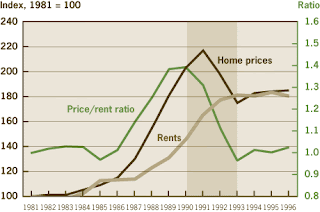by Calculated Risk on 2/12/2009 11:16:00 AM
Thursday, February 12, 2009
Fed Paper: Effective Practices in Crisis Resolution
Here is an interesting economic commentary from Cleveland Fed researchers O. Emre Ergungor and Kent Cherny: Effective Practices in Crisis Resolution and the Case of Sweden A few excerpt:
We maintain that the goal of any resolution strategy should be to transfer assets from failed financial institutions to institutions that can put the assets to their most efficient use, and at the least possible short and long-term costs to the taxpayer. As in most things, this is easier said than done. When faced with financial markets and institutions that appear to be spiraling out of control, regulators and policymakers often resort to blanket guarantees of uninsured deposits and other liabilities by providing unlimited liquidity to financial markets until the crisis dissipates.This is why the stress test must be completed quickly (30 days is probably sufficient), and the results should be made public. Last night I listed the three probable categories for the banks: 1) no assistance needed, 2) additional capital needed, and 3) Nationalization needed. I believe this should be fully disclosed and announced publicly in mid-March.
While blanket guarantees might be policymakers’ best choice given the urgency of bringing some calm to markets, history shows that such guarantees have their dangers: they bail out investors who should have done a better job at evaluating and managing their risks and disciplining financial institutions that were mismanaging their money.
...
Most important, according to Ergungor and Thomson, is that successful crisis resolutions have been characterized by transparency. When officials move to contain a financial crisis, their primary task is to identify which institutions are viable and which assets are good, and conversely which institutions are insolvent and which assets are bad. This triage and full disclosure of associated losses clears the uncertainty surrounding the financial institutions and makes it possible for the viable institutions to raise new funds from private investors or from the government if private sources are not available. Failing to acknowledge the true value of assets or the condition of troubled banks early on makes it easy for them to live on as propped up “zombies” (as happened in Japan during the 1990s)—healthy on paper but economically insolvent. Initial full disclosure avoids these situations, and improves efficiency during industry restructuring.
emphasis added
There is much more in the paper.
One of the questions is how big was the Swedish bubble?
 Click on graph for larger image in new window.
Click on graph for larger image in new window.This graph (from the Cleveland Fed paper) shows that real estate prices more than doubled in the 1980s and then declined sharply in the bust. The price-to-rent ratio increased by about 40% before returning to normal.
And how does this compare to the U.S. housing bubble?
 This graph shows the Case-Shiller National price index through Q3 2008 (most recent data, Q4 to be released later this month). This shows that prices double in the U.S. during the recent housing bubble.
This graph shows the Case-Shiller National price index through Q3 2008 (most recent data, Q4 to be released later this month). This shows that prices double in the U.S. during the recent housing bubble.This graph is in nominal terms as is the Swedish graph (not inflation adjusted). Note that prices in Sweden declined, but didn't fall to earlier levels.
Real prices, price-to-rent and price-to-income measures all probably provide better estimates of how far prices will fall.
On price-to-rent, here is a similar graph through Q3 2008 using the Case-Shiller National Home Price Index:
 This graph shows the price to rent ratio (Q1 1997 = 1.0) for the Case-Shiller national Home Price Index. For rents, the national Owners' Equivalent Rent from the BLS is used.
This graph shows the price to rent ratio (Q1 1997 = 1.0) for the Case-Shiller national Home Price Index. For rents, the national Owners' Equivalent Rent from the BLS is used.Looking at the price-to-rent ratio based on the Case-Shiller index, the price-to-rent increased more in the U.S. than in Sweden, and the ratio still has to decline further (although we don't have the data yet, this ratio definitely declined further in Q4 2008).
Just to repeat, the key lesson in crisis resolution is transparency. I hope the results of the bank stress test will be made public, and the zombie banks clearly identified.


